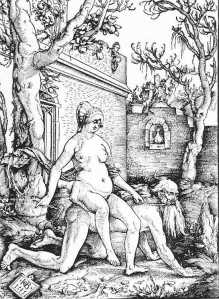 A favourite subject of Renaissance artists, the cautionary tale of Aristotle and Phyllis is a great example of how much knowledge goes into historical analysis.
A favourite subject of Renaissance artists, the cautionary tale of Aristotle and Phyllis is a great example of how much knowledge goes into historical analysis.
Sixteenth century versions recounted how Phyllis, a wife or courtesan of Alexander the Great, was so beautiful that she charmed even his legendary tutor, Aristotle. Seeking to avenge herself for an earlier slight by the counsellor, Phyllis had Aristotle prove his devotion by agreeing to wear a bit and bridle, then be ridden around by Phyllis in a palace garden where he presumed (wrongly!) that they would not be seen. Silly Aristotle! Phyllis arranged for Alexander to witness her triumph and poor Aristotle was left to explain to the young king that if a woman could achieve this with a wise old man, how much more vulnerable were young men!
Sometimes when I teach early modern history, I begin the course sharing a selection of images from the time, including this one. At first, students mostly don’t know what to make of it. They don’t know the story. Some of them don’t know Aristotle! So I tell them the story and a bit about the significance of Aristotle, then I ask them to examine the image again, maybe picturing themselves as a sixteenth century woman or man, encountering this image. How would he or she react? What concepts and beliefs might this image challenge or reinforce? If they know the Wife of Bath’s Tale, how do these compare? What do they think might be a “good Christian” attitude about this story given what they know of the period? Would anyone have spoken for Phyllis (just as, not quite a century later, Montaigne pondered lighting a candle for St. Michael’s dragon)?
Then there are all the questions I don’t even know enough to ask of them or myself.
It’s a useful reminder of how much we have to know to get into the mindset of a historical time – we have to know about Aristotle, we have to know about this story, we have to know about sexual norms and there’s so much more. We can instinctively smirk when we see the world turned upside down, with Phyllis triumphant, but we should also think how much this picture reinforced quite the opposite.

I’m always stumped by the things my students don’t know. One had never heard of ‘court’ in any context other than judicial courts. So when I was talking about royal courts, zie heard ‘judicial court’ which got fizzes when I talked of court intrigues and perversions of justice. King’s court meant where kings were put on trial. Gah.
See you at Berks! I too am arriving Wednesday; doing the Sojourner Truth thing on Thursday.
That’s interesting, Belle – I haven’t had a student confess to that confusion but I bet you dollars to donuts that some of mine have that confused, too. They’re also woefully ignorant of the Bible: some elements as simple as who were the four apostles and what are the Ten Commandments. I don’t want to turn my class into Religious Studies 101 but when I have to explain some very basic concepts, I wish I had a whole network of weblinks handy to just point out to them: “Read this and learn what this term means!”
I think I’ll be at Historic Deerfield on Thursday – can’t wait to see you when we’re there, though. I will send you an email so you have my contact information so we can connect before the Blogger meet-up.
Erm…twelve apostles or four evangelists :-)
And I’m afraid Religion (or rather Christianity) cannot very well be left out of your class, if you are teaching the kind of subject I think you’re teaching.
Keep fighting for culture and best regards from Italy.
Doh! Mistyped there, most definitely. We do spend a lot of time on religion in this course. I’m gearing up to teach a related class on the Reformation and Catholic Reformation next term. We’ll be knee-deep in theology, religious history and other fun.